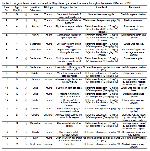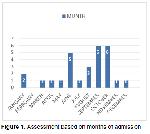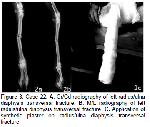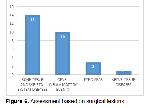As gazelles are animals that are sensitive, fast and hard to hold and capture, the probability of injury during the capturing process of these excitable animals is high. Severe injuries and deaths are very frequent while catching especially excessively aggressive and exhausted gazelles
1,12,20-22.
It was reported that mating in goitered gazelles (Gazella subgutturosa) takes places in the months of October to December 23, and it even continues until mid-January 2. It was emphasized that adult males in their mating period determine their territory, and in the estrous period, they are really aggressive towards other males without the need for female presence, they fight in the form of threatening, crushing and headbutting until they beat their opponent, and horn impacts in these fights may lead to fatal injuries 2,23-25. Leclerc et al. conducted a retrospective study on greater kudu and determined that problems related to intraspecies aggression, inappropriate holding conditions, stress, crashing fences, capturing procedures or captivity may be a cause of trauma, the rates of trauma encountered in males are similar to those in females although in-herd fights among wild males of 4-7 years of age are frequent, and the age intervals of gazelles who have trauma/accident lesions are close (juvenile (27%), subadult (25%), adult (18%) and old (25%) 26. Nisbet et al. investigated the traumatic injuries of 20 roe deer (Capreolus capreolus) in a retrospective study and reported that the most frequent admissions were made in the months of June, July and November, and these were more frequent among males (n:12) than females (n:8) 27. In this study, in contrast to the findings of Leclerc et al. 26 and Nisbet et al. 27, it was seen that trauma lesions were more frequent in females [19 females (68%), 9 males (32%)], and the lesions were seen mostly in juvenile gazelles [17 cases, 0-12-month-old (60.71%)]. Again, in difference to the study by Nisbet et al. 27, it was determined that there were more admissions in the months of September (21%) and October (21%). It was thought that the finding of the study on higher rates of trauma in female gazelles may be related to keeping these animals far from natural life in places such as houses and farms, their conditions of living and captivity-related stress as stated by Leclerc 26, and several other authors 19,20,23-25, the reason for the lesions in male gazelles may be their attempts to fight other males as they determined their territory and became more aggressive in the fall months where their estrous period started. The finding in our study that the admissions in the months of February (0%), March (3%) and April (3%) were the lowest was considered to be the result of the end of the mating period and the pregnancy status of females, which may have resulted in reduced aggression in males.
Nisbet et al. 27 stated that they encountered long bone fractures the most (n: 8) in roe deer, and among these bones, the most frequently broken ones were femurs (n: 4). In this study, with 14 cases (50%), the most frequently encountered condition was bone tissue and skeletal system disease. The highest number of femoral (n: 3) fractures in 8 patients with long bone fractures among bone tissue and skeletal system diseases was found to be consistent with the findings of Nisbet et al. 27.
In this retrospective study, among the juvenile and subadult gazelles, 17 were 0-12 months old (60.71%), 9 were 12-24 months old (32.14%) and 2 were 24-36 months old (7.14%), and these gazelles had more traumatic lesions, while no gazelle over the age of 3 was admitted. The reasons for observing more fractures in juvenile and young gazelles may include anatomic factors such as that their bone development has not been completed yet, their bones do not have sufficient resistance, and lack of complete fusing in their epiphysis lines, as well as issues such as that young gazelles do not yet have the experience that would protect them from dangers in their environment, and they have careless and active traits.
Several authors 7,8,10-15 have reported that situations of excessive excitement, fear and panic when gazelles are captured may lead to the acute stress known as CM that may result in sudden death, and the possibility of CM makes capturing gazelles, immobilizing them, and performing simple interventions, anesthesia and operative interventions more difficult. Some authors stated that opioid combinations in wild animals increase the risk of CM by causing excitement, spontaneous mobility, muscle rigidity, hypoventilation, catecholamine release and hyperthermia 11,28, and they recommended the use of benzodiazepines such as zolazepam, diazepam and midazolam which provide a very good level of muscle relaxation by reducing muscle spasm and spasticity 11. As reported by other authors 11,28, in this study, usage of the combination of tiletamine-zolazepam for immobilizing gazelles resulted in highly successful outcomes.
As a result, since gazelles have a timid and excited nature, more care should be taken in interventions to prevent complications that can cause sudden deaths, such as CM. Since the anesthesia protocols used in the current study did not cause any complications in gazelles, it was concluded that it could shed light on the veterinary clinicians working in the field and future studies to be carried out.










